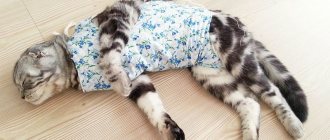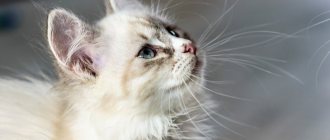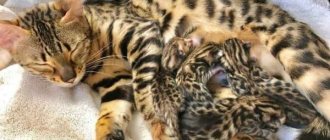How to tell if a cat is pregnant at home
Gestation by a cat lasts 58-70 days.
The period depends on the breed, age, number of fruits. The first signs of pregnancy in the first week are hidden, after two to three weeks of fertilization the first symptoms appear: toxicosis, drowsiness, frequent urination, changes in the mammary glands and behavior.
Cat behavior during pregnancy
During pregnancy, a cat undergoes a restructuring of the body, and morning sickness appears. The animal becomes lethargic, refuses food, outdoor games, communication with the owner, and visits the litter box more often.
Toxicosis is a temporary phenomenon, so the female’s appetite soon returns to normal and in some places increases. Taste preferences also change. The expectant mother asks for what she previously refused: raw meat, cheese, butter, olives. If there is a lack of vitamins, a cat may chew plaster, wires, or eat its own fur.
A pregnant pet, having gotten used to the situation, eventually becomes affectionate, requiring more attention and care.
Termination of heat
Cats go into heat differently. It occurs either once every three months and lasts up to 20 days, or once a month and lasts 3-5 days. Can a pregnant cat go into heat? Definitely no.
Typically, fertilization after mating occurs within 20-45 hours. Once conception has occurred, estrus stops. The female stops calling the cat, does not arch her back, does not roll on the floor, and calms down.
Abdominal rounding
You can tell if a cat is pregnant by looking at its belly. Starting from the 5th week, it becomes rounded and dense, located behind the ribs. At week 6, the growth of the abdominal cavity increases: an experienced veterinarian will determine the number of fetuses by palpation.
Rapid enlargement of the abdomen begins at 8 weeks. It lowers, positioning itself closer to the hips. By placing your hand on your stomach, you can feel the kittens moving.
Swelling of the nipples
Two weeks after mating, the cat's nipples become bright pink and enlarge due to hormonal changes. After 7 weeks, the hair surrounding the nipples partially falls out.
3-5 days before the birth of kittens, the mammary glands produce colostrum.
Growing up
Usually the first heat occurs at the age of 11-12 months. The presence of hormonal changes leads to the fact that estrus occurs much earlier. For example, facts of the appearance of estrus in 5-6 month old kittens were recorded, and pregnancy may already occur at this age. Such early fertilization is fraught with pathologies, because the mother cat’s body is still developing, and pregnancy is a huge burden that is difficult for a teenage kitten to cope with.
Experts advise not to allow cats with early onset of estrus to be mated. It is believed that this tendency is a hereditary problem. If your pet is in heat before the age of 8 months, this is a deviation from the norm. The same applies to late estrus. If an animal has not had estrus after one and a half years, it must be shown to a veterinarian.
Empty heats can harm the health of the ward. Purulent diseases of the uterus that occur against the background of frequent empty estrus require the help of a veterinarian, and in some cases the animal dies without surgery.
X-ray of a pregnant cat as a diagnostic method
An X-ray image is used to identify the pathology of an animal’s pregnancy, count the number of embryos, and assess the quality of health of future offspring. The skeletons of kittens are visible after 44 days of fertilization.
In the early stages, x-rays are not indicated, since the image will only capture the tissue of the uterus.
The procedure involves the correct position of the cat: on its side or on its back. This position allows you to count the number of kittens by correlating the number of skulls and spines.
Antibody test
Antibodies to coronavirus detected in the body show its reaction to the pathogen. If it produces specific immunoglobulins, this may mean that:
- the person has had COVID-19 (including asymptomatic);
- antibodies are able to fight the virus if it re-enters the blood;
- a person can be a donor and save other infected people who suffer more severely from the disease.
If testing shows that antibodies to coronavirus are present, this does not mean that their carrier will never get sick again.
Although the statistics are small, virologists have concluded that a positive antibody test may briefly equate to vaccination. However, this is true for six months after the infection is detected. After this period, risks reappear, and the patient is recommended to be vaccinated.
Determining if a cat is pregnant using ultrasound
Ultrasound of a cat during pregnancy is a common, painless and quick way to determine the period and problems of bearing offspring. The study will allow timely recognition of deteriorating animal health.
Diagnostics helps to see embryos as early as 2 weeks of pregnancy. After 4 weeks, the specialist will determine the exact number of kittens, check the activity of their hearts, and the condition of the cat itself. The movement of the fetuses is recorded, body parts and internal organs of the kittens are recognized. By the end of the 8th week, it is important to determine whether the amount of amniotic fluid is decreasing: the kittens are swallowing liquid. Reducing water levels and the size of the fetuses help the specialist determine the estimated due date for the pet.
How to determine how far along a cat's pregnancy is
The gestational age of a cat is determined taking into account the following characteristics:
- 2-3 weeks: nipples turn pink, swell, activity decreases, appetite disappears, morning vomiting, drowsiness;
- 4-5 weeks: the belly is rounded, increasing in size, appetite increases;
- 6-7 weeks: weight gain by 1.5-2 kg, the belly grows faster, being located closer to the hips, the cat becomes affectionate, requiring increased attention;
- 8-9 weeks: the belly goes down, a significant weight gain, the kittens are felt moving, the cat begins to worry, tries to be closer to the owner, looks for a secluded place of birth, lies more, eats a lot, often goes to the litter box, nipples secrete colostrum.
How to detect a false pregnancy in a cat
The condition of a false pregnancy in a cat is not uncommon. More often, sphinxes, oriental cats, rexes, and Siamese are subject to it, inheriting the vice from their parents.
False pregnancy is a condition in which an unfertilized cat experiences symptoms of pregnancy.
Causes of abnormal behavior:
- mating occurred with a sterile/castrated or sick cat;
- the female’s genitourinary system is disrupted;
- the cat has congenital hormonal disorders, in which a false pregnancy occurs without mating with a male.
False pregnancy is classified as a mental illness in animals.
Signs of false pregnancy:
- lethargy, increased sleep duration, increased anxiety;
- alienation or persistent begging for human affection;
- finding a place to give birth;
- caring for a sock, a soft toy, carrying it in your teeth like a kitten;
- frequent licking;
- slight discharge from the genitals and nipples;
- rounding, thickening of the abdomen;
- enlargement of the mammary glands;
- surges in appetite;
- improper functioning of the gastrointestinal tract;
- slight increase in body temperature.
Ultrasound diagnostics will make it possible to more accurately determine a false pregnancy.
The birth process
Kittens ready to be born line up to be born in the animal’s two-horned uterus. The birth process is divided into 3 stages:
- The cat feels contractions of the uterus and at the same time the urge to have a bowel movement. The cervix begins to open slightly. Often at this stage the birth plug comes out along with mucous secretions.
- In the second phase, contractions become more intense and painful, the cervix opens completely, preparing to let the kittens move through the birth canal. The cat strains, trying with all her might to “push through” the cubs. This is how a healthy kitten is born with a favorable course of labor. If the amniotic sac has not burst earlier, the baby is born in it. Usually the woman in labor frees the kitten herself by gnawing the shell. But it happens that she leaves the place of birth in fright or gets lost during the first lambing, and then you must come to the rescue by cutting the bladder with sterile scissors so that the baby does not suffocate. The next cub should emerge 15, maximum 40 minutes after the first.
- At the final stage of labor, the placenta is separated from the mother. The cat must eat one of the nursery places - this will help her quickly realize that she is a mother and speed up lactation. Make sure that after each kitten there is an afterbirth. The placenta remaining in the pet’s body can rot, which will lead to severe inflammation and even death of the animal. At the same time, the cat may eat a stillborn or too weak kitten, which is best avoided.
Well, the birth is over. Make sure your pet has given birth to all the kittens by feeling her belly: it should be soft and empty. If you still have doubts, and the cat is in no hurry to feed and caress the cubs, but still shows signs of anxiety, seek advice from a specialist.
You can also contact our site's staff veterinarian, who will respond to them as soon as possible in the comment box below.
When mating has taken place or if the cat has run away from home during estrus, it is important to determine pregnancy as early as possible. The hormonal levels in the animal’s body change, so pregnancy affects the mood, behavior and appearance of the pet. It is often difficult for inexperienced owners to understand at home whether their cat is expecting a replenishment. Timely detection of signs will allow the cat to receive the necessary assistance for a successful birth in the future.
- Show all
How to detect a frozen pregnancy in a cat
Frozen pregnancy is a common phenomenon in which one or all embryos die in utero. This happens due to hormonal imbalances, infectious diseases, various pathologies of the body, poisoning with chemicals and drugs. In severe cases, miscarriage or death occurs due to infection of the body with cadaveric poison.
Ultrasound can detect non-viable embryos. If a pathology is detected, labor is stimulated. The problem cannot be delayed: a dead fetus is susceptible to decomposition, leading to infection of the cat’s body.
If live kittens are found, the pregnancy is not terminated. Dead fetuses will be released naturally during childbirth.
If a frozen pregnancy recurs, then the question of castration of the female arises.
Pregnancy in cats has some peculiarities that every breeder needs to know. The onset of fertilization and high-quality gestation of offspring is facilitated by puberty and the age of the female, depending on the breed, care, and climate. The optimal age for mating is 1.5 years.











